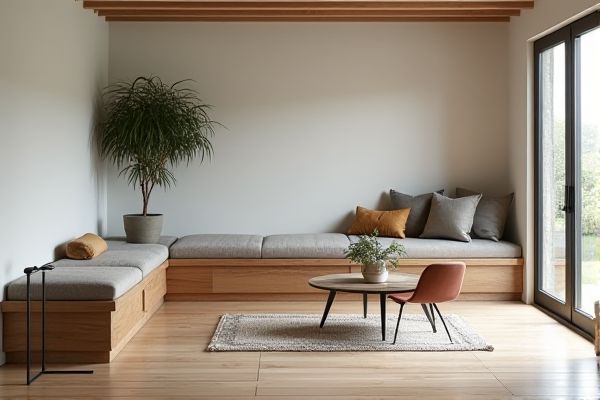
An L-shaped bench maximizes corner space and provides more seating area compared to a straight bench, which is simpler and better suited for narrow or long spaces. Discover which bench style best fits Your living area and enhances functionality by reading the rest of the article.
Table of Comparison
| Feature | L-Shaped Bench | Straight Bench |
|---|---|---|
| Design | Corner, L-shaped layout | Linear, straight layout |
| Space Utilization | Maximizes corner space | Requires linear wall space |
| Seating Capacity | Higher, fits more people | Lower, fits fewer people |
| Versatility | Ideal for corners, lounges | Fits narrow or standard areas |
| Comfort | Supports varied seating angles | Supports straight seating only |
| Installation | More complex, corner fitting | Simple, straightforward setup |
| Common Uses | Living rooms, patios, offices | Dining rooms, gyms, workspaces |
Understanding L-Shaped Benches
L-shaped benches maximize corner space utilization, offering greater seating capacity compared to straight benches by fitting snugly into room corners. Their design enhances social interaction by allowing people to face each other while seated, unlike straight benches that align seats in a single row. Ideal for both indoor and outdoor settings, L-shaped benches provide versatile placement options and contribute to a more cohesive and intimate seating arrangement.
Key Features of Straight Benches
Straight benches feature a linear design ideal for maximizing seating along narrow spaces or walls, often equipped with a solid backrest for enhanced support and comfort. They typically offer uniform cushioning and a streamlined silhouette, making them versatile for various interior styles from modern to traditional. Their simplicity allows easy integration into dining rooms, entryways, or outdoor patios, providing straightforward functionality with minimal spatial complexity.
Space Utilization: L-Shaped vs Straight Benches
L-shaped benches maximize space utilization by fitting neatly into corners, creating additional seating without occupying excessive room. Straight benches require more linear space and often limit seating to one side, which may reduce efficiency in smaller areas. Choosing an L-shaped bench can optimize your layout by making better use of corner spaces and enhancing flow in compact environments.
Design Versatility and Aesthetics
L-shaped benches offer superior design versatility by fitting seamlessly into corner spaces, maximizing seating without disrupting room flow, and providing a cozy, intimate atmosphere. Straight benches deliver a sleek, minimalist aesthetic that complements modern and traditional interiors, making them a versatile choice for various settings. Your design choice should consider room layout and style preferences to enhance both functionality and visual appeal.
Comfort and Seating Capacity Comparison
L-shaped benches offer enhanced comfort by providing corner support and more ergonomic seating arrangements compared to straight benches, which may feel rigid and limit movement. The L-shape design increases seating capacity by utilizing corner space efficiently, allowing more people to sit comfortably at once. Your choice between these benches should consider the balance between space optimization and the preferred social interaction layout.
Best Use Cases for L-Shaped Benches
L-shaped benches excel in corner seating solutions, maximizing space in compact rooms or small patios by utilizing underused corners effectively. Their design supports social interaction, making them ideal for communal dining areas, office lounge spaces, and outdoor gatherings where multiple users need comfortable, contiguous seating. They also enhance privacy and define zones within open floor plans, providing both functional seating and aesthetic division.
Ideal Scenarios for Straight Benches
Straight benches excel in compact spaces where linear seating aligns with room layouts, such as dining areas or workout zones requiring efficient use of narrow walls. They provide versatile, accessible seating ideal for small gatherings or solo exercises, complementing minimalist interiors and maximizing floor space. Their simplicity facilitates easy repositioning and integration with tables or gym equipment.
Installation and Placement Considerations
L-shaped benches offer versatile installation options ideal for corner spaces, maximizing seating without occupying extensive floor area, while straight benches require less complex fitting and can be placed along any linear wall. Installation of L-shaped benches often demands precise corner measurements and may need custom carpentry, whereas straight benches typically allow for straightforward mounting with standard brackets. Placement considerations include using L-shaped benches to create intimate seating nooks or define room boundaries, contrasted with straight benches enhancing open layouts by lining hallways or walls efficiently.
Cost Implications: L-Shaped vs Straight Benches
L-shaped benches typically cost more than straight benches due to increased material use and more complex manufacturing processes. Straight benches offer a budget-friendly option with simpler designs and easier installation, making them ideal for smaller spaces or cost-conscious projects. Your choice between the two will greatly impact your overall budget, balancing space utilization against upfront expenses.
Which Bench Style Suits Your Space?
L-shaped benches maximize corner spaces, providing ample seating while maintaining an open floor plan, ideal for compact or irregular rooms. Straight benches offer versatile placement along walls or tables, fitting well in narrow spaces and promoting easy movement around your furniture. Your choice depends on room dimensions and seating needs, balancing aesthetics with practical space optimization.
 homyna.com
homyna.com